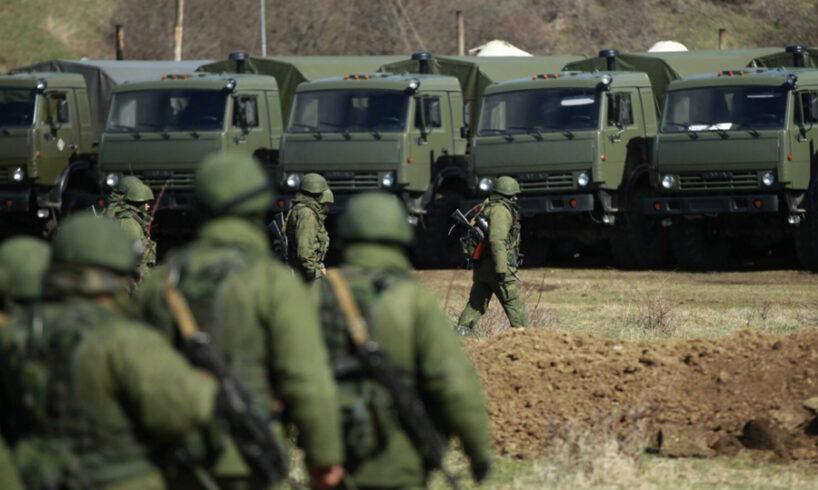
Since 2014, Crimea has remained under illegal Russian occupation. During this time, the peninsula has been viewed by much of the world as a “disputed territory” or even a potential bargaining chip in the peace process. However, with the start of the full-scale Russian invasion, it became clear that Crimea serves not only as a military base but also as a platform for committing war crimes, carrying out systematic repressions, and executing strategic manipulations.
Crimea as a military launchpad for invasion
Since the beginning of the occupation in 2014, Russia has turned Crimea into a strategic military base. Shortly after its illegal annexation, the peninsula became a key hub for the Russian Black Sea Fleet and a center of regional militarisation: military infrastructure expanded rapidly, with new missile systems, aviation units, air defense systems, and more deployed. According to Ukraine’s Ministry of Foreign Affairs, as of fall 2019, Russia had stationed 40 tanks, 583 armored vehicles, 162 heavy artillery systems, 122 combat aircraft, 62 helicopters, and 12 multiple rocket launch systems in Crimea. Additionally, 34 Russian warships and seven submarines were already operating in the region.
It was from occupied Crimea that Russia launched its offensive against southern Ukraine in the early days of the full-scale invasion. The peninsula was used as a launchpad, allowing the Kremlin to coordinate attacks on ground targets, firing missiles at civilian and military sites, and using both aviation and naval forces. After the initial assault has stalled, the peninsula continues to serve as a launch point for strikes on the surrounding Ukrainian regions: Bessarabia, Prychornomoria, Tavria, Pryazovia, Podniprovia and Zaporizhzhia.
Russia uses Crimea actively for several reasons. First, its convenient rail and road connections allow quick delivery of troops, fuel, equipment, and ammunition, which are then moved to the front lines stretching nearby. Second, Russia’s Black Sea Fleet, based in Sevastopol after Crimea’s 2014 occupation, uses the peninsula as both a staging area and a launching platform for missile strikes and maritime reconnaissance. Third, Crimea’s proximity to the front makes it a convenient base for launching drones and rockets. Since the distance from Crimea is shorter, missiles reach their targets faster, which also gives the Ukrainian forces less time to react.
Deployment of Russia’s military equipment to Crimea
Due to its convenient logistical location, Crimea has become a main route for transporting weapons, troops, and supplies to the temporarily occupied territories of Ukraine.
Before military equipment is sent to the front, it often needs to be serviced or repaired. For this, Russia has built the necessary infrastructure in Crimea — repair bases, technical stations, and workshops. Old farms, factories, and industrial buildings have been widely repurposed into storage sites for ammunition, fuel, and other military supplies. In 2018, journalists from the Ukrainian media Crimea.Realities discovered abandoned cowsheds in the area. By 2019–2020, a large military facility had already been constructed there — a storage base intended for use in the event of a full-scale war. This is not an isolated example; Russia began constructing such bases long before the full-scale invasion.
Additionally, the peninsula has become a key center for conducting military exercises, with many military units and barracks built after 2014 to accommodate Russian troops and civilians from Crimea who have been forcibly conscripted into the Russian army. In 2015 alone, two out of six planned dormitories were completed for the 126th Separate Coastal Defense Brigade and the 8th Artillery Regiment of Russia’s Black Sea Fleet to quarter up to 1,800 occupying troops. According to multiple reports, over 10,000 apartments were built between 2014 and 2021 across different parts of the peninsula to house Russian servicemen and their families. In 2023, the Russian government passed a law guaranteeing housing for soldiers fighting in the war against Ukraine. These servicemen were also granted simplified procedures for registering ownership of these homes.
How Russia violates international treaties on the militarisation of occupied territories
The militarisation of Crimea clearly shows Russia’s disregard for the safety and well-being of the local population. Many Crimean residents understand that their lives have become hostage to war — the peninsula has been turned into a massive military base, and people are effectively used as a resource to serve the needs of the occupying forces. Moreover, Russian forces deliberately integrate civilian infrastructure into their military strategy, constructing facilities near residential areas to reduce the likelihood of Ukrainian strikes. The coordinator of the Yellow Ribbon resistance movement reported that residents of Sevastopol — the administrative capital and the headquarters of the Russian Black Sea Fleet — have repeatedly complained about the construction of military sites close to their homes, significantly increasing the danger for civilians.
“Yellow Ribbon”
Is a public resistance movement in the temporarily occupied territories of Ukraine, created in April 2022 after the Russian military invasion. The goal of the movement is informational resistance to the Russian occupiers.
Russia’s military presence on the peninsula also fuels the crackdowns on local activists, public society, and civilians loyal to Ukraine. Faced with the constant threat of forced mobilisation and repression, more than 200,000 residents have been forced to flee as of July 2024, as reported by the Permanent Representative of the President in the Autonomous Republic of Crimea. This decision requires careful planning, as Russian occupation forces strictly monitor and control departures from the peninsula.
Illegal mobilisation of Crimeans into the Russian army
Forced mobilisation of Crimean residents began immediately after the 2014 occupation of the peninsula, but the most active waves started following the full-scale invasion in 2022. Forcing civilians in occupied territories to serve in the occupying power’s military is a violation of Article 51 of the Fourth Geneva Convention. According to the Mejlis of the Crimean Tatar people, up to 25,000 draft notices were issued, with 90% of them handed specifically to Crimean Tatars.
Many Crimean residents initially refused to accept Russian citizenship. However, due to severe restrictions, such as denial of access to medical care, education, employment, pensions, and direct threats, they were forced to obtain it. Holding a Russian passport automatically makes every man eligible for military service and, consequently, for mobilisation. Procedural violations often accompany the draft. Military enlistment offices routinely reject medical certificates, while officials often ignore or destroy deferral and exemption documents on the spot. Occupation authorities also dismiss religious beliefs as valid grounds for exemption, despite their prior recognition under Ukrainian law.
The Mejlis
Is the sole supreme representative and executive body of the Crimean Tatar people. It was established in 1991.
Open sources also report repeated cases of men being detained in the streets directly after work by enlistment officers, often being taken immediately to enlistment offices. Detainees are not informed of their whereabouts or what will happen next; occupying forces instruct them to turn off their phones and deny any contact with their families. Under physical and psychological pressure, many are coerced into signing “voluntary” applications to join the Russian army.
Former Presidential Representative in Crimea Tamila Tasheva reported that in 2023, approximately 44,500 Crimean residents were conscripted into the Armed Forces of the Russian Federation. Others try to avoid the draft by not staying at their registered address, hoping to keep away from the visits of military offices or security agents.
Those who ignore draft notices, avoid military offices, or skip medical check-ups face administrative fines that increase over time. Furthermore, police put such individuals on wanted lists. The occupying authorities track them using phone data, social media activity, and street surveillance. Men who try to leave the peninsula but fall under the mobilisation category are stopped at checkpoints and denied exit. Filing a legal complaint against such persecution is futile — most end up with penalties and forced enlistment anyway.
Human rights violations in Crimea
Since the full-scale invasion in 2022, Russia has significantly intensified repression in occupied Crimea. People who openly support Ukraine are often harassed, arrested, and sentenced on fabricated charges. At the same time, journalists, volunteers, and activists are targeted with fines, illegal imprisonment, and torture. In 2024 alone, Russia conducted 61 warrantless home searches, carried out 109 interrogations or so-called “conversations” with residents, and unlawfully detained 111 civilians. Those convicted are often denied contact with their families and have no access to proper legal defense.
Besides illegal raids, local activists live under the constant threat of detention and criminal allegations based on trumped-up charges. Sabina Ilyasova, a project coordinator at the Crimean human rights organization CrimeaSOS, reported that in occupied Crimea, abductions of people happen every three days. Those taken are usually accused of helping the Ukrainian army or intelligence. Every day, at least one person is arrested for posting Ukrainian songs online or other minor gestures of solidarity with Ukraine, for instance, women painting their nails blue and yellow. According to Ilyasova, at least 140 civilian hostages and political prisoners face inhumane treatment in prisons.
The abuse is not limited only to civil society activists, as Russian security forces often raid the homes of their relatives. For instance, in April 2024, the Russian Federal Security Service (FSB) searched the house of 74-year-old Halil Halilov, father of the Crimean Tatar journalist Gulsum Halilova. The man, who suffers from hypertension, couldn’t get out of bed during the raid, in which the agents were searching for banned literature, weapons, and other items, only to find nothing.
The human rights abuse often proceeds in detention facilities, where detainees are usually subjected to torture and pressure to extract confessions or fabricate charges of espionage, extremism, or terrorism, punishable by the Russian penal code with lengthy prison sentences. Some people are released after a few days, often with threats and warnings that they are now being watched. Others face trials and prison sentences based on fake charges. Tetiana Pechonchyk, the head of the board of the ZMINA Human Rights Center, reported that as of 2025, 105 people were imprisoned in Crimea without clear charges, including 52 cases of alleged espionage. About 1,300 people were fined, arrested, fired from their jobs, or forced to record repentant videos denouncing their sympathy for Ukraine.
In 2017, FSB officers kidnapped Rinat Paralamov, who had refused to accept Russian citizenship. He was tortured with electric shocks to force him to give up the names of other Crimean Tatars allegedly connected to “Hizb ut-Tahrir”. They also tried to pressure him into cooperating, threatening his entire family. After the torture, the man was dumped near a train station in Simferopol, where activists found him. Later, Rinat and his family were forced to move to Kyiv to protect their lives.
Russia’s occupational administration often weaponises health conditions as a repressive tactic. While in custody, Russians systematically ignore prisoners’ health conditions — or deliberately deny them essential care. In 2023, two Crimean political prisoners, Kostiantyn Shyring and Dzhemil Gafarov, died after being denied medical care. As of fall 2024, there were 67 Ukrainian citizens in poor health and in need of urgent medical care who were being illegally imprisoned in Crimea.
Hizb ut-Tahrir
Is an Islamic political party that is classified as a terrorist organization under Russian law. However, it is not banned in Ukraine or in most countries around the world.
Besides activists and civil society leaders, independent lawyers who represent these political prisoners are also being systematically targeted. In 2022, three Crimean Tatar lawyers known for their human rights activism — Lilia Hemedzhi, Rustem Kyamiliev, and Nazim Sheikhmambetov — had their licenses revoked without allowing them to contest the decision. In July 2023, human rights lawyer Oleksii Ladin was disbarred for defending detained Crimean Tatars and Ukrainians in political trials. Activists and families of political prisoners say these actions are aimed at blocking the right to legal defense and a fair trial.
The persecution of Crimean Tatars as indigenous peoples
The persecution of Crimean Tatars — the indigenous population of Crimea — goes far beyond the full-scale invasion. It goes back to the 18th century, when the Russian Empire first occupied the peninsula. Since then, the restrictions imposed on language, traditions, and religion became a permanent feature of Russian colonial policy. The attempts to eliminate the presence of the Crimean Tatars in their homeland reached its peak in the 1944 mass deportation, where the entire Crimean Tatar population was forcibly displaced to the remote areas of the USSR and were prohibited to return till the final years of the Soviet era.
The persecutions resumed after the Kremlin forces occupied the peninsula again in 2014. Since then, Moscow has used various methods to erase the Crimean Tatar identity, reinforcing the historical myth of the “Russian Crimea”. Russian security services, police, and military forces have regularly raided Crimean Tatar homes. According to the Crimean Tatar Resource Center, in 2023, the occupational authorities conducted 65 searches, 46 of which took place in the homes of Crimean Tatars. They searched for Ukrainian symbols, banned books, weapons, or any signs of affiliation with so-called “terrorist Nazi organizations” that Russian propaganda uses as a pretext to justify the unprovoked invasion of Ukraine and illegal occupation of the peninsula.
Most of the time, such raids found nothing. If the family were lucky, the officers would leave after wrecking the house and terrifying its residents. According to people who managed to leave the peninsula, at least one family member — usually a man would be taken for interrogation. The “reason” could be anything — from “suspicious behaviour” to fabricated evidence that the Russian law enforcement plants during the raid, most commonly, books banned under Russian law. Practiced since 2014, this policy primarily aims to intimidate residents and compel them to cooperate. If people refuse, harsher methods are used, such as detentions and interrogations.
This sort of institutionalised abuse disproportionately targets the Crimean Tatars. According to the Crimean Tatar Resource Center, in 2023 alone, 119 of 173 recorded arrests (69%) targeted the indigenous Crimeans. As of February 2025, the Representative of the President of Ukraine in the Autonomous Republic of Crimea has identified 221 Crimean political prisoners, with 134 of them being Crimean Tatars. Experts call these actions a form of hybrid deportation, as threats, repression, and forced conscription are pushing Crimean Tatars to flee their homeland.
Recently, Russia has increasingly accused Crimean Tatars of links to the Islamic organisation Hizb ut-Tahrir, banned in Russia, giving it a convenient tool to justify arrests. In March 2024 alone, Russian forces carried out the third-largest wave of raids since the beginning of the occupation, arresting ten Crimean Tatars on charges of affiliation with the organisation.
Crimea as a transit hub and prison for Ukrainians from the occupied territories
Besides direct abuse of local residents, Russia has turned Crimea into a key hub for the retention of Ukrainians it abducts from the occupied territories: children, civilian hostages, prisoners of war, former Ukrainian servicemen, and local officials. These detention facilities operate under the complete control of the FSB, which is actively involved in political repressions. Like in the case of local residents, detainees are often coerced into signing falsified confessions and statements alleging that the Ukrainian Armed Forces attacked civilian targets — the narrative the Kremlin propaganda uses to justify the occupation as a way of “protecting” the local population.
Russian occupation authorities primarily use Crimea as a temporary detention hub, later transferring captive Ukrainians to investigative detention centers, Russian prisons, or so-called “filtration camps”, complicating their identification and return. Others are simply abandoned, forced to seek shelter on their own. In this way, the peninsula functions as a grim transit zone in a larger system of repression.
Filtration camps
Special facilities created by the Russians to hold civilians and prisoners of war for the duration of checks.
Ex-servicemen who didn’t escape the occupation and Ukrainian prisoners of war are subjected to intensive interrogations and torture. In the early days of the full-scale invasion, the Kremlin’s program article announced the eradication of Ukrainians capable of resisting as one of the war goals. Tamila Tasheva reported that in July 2022, the FSB had even created a special unit responsible for conducting interrogations and torture. Besides systematic physical and psychological torture, detainees are then held in hospitals or penal facilities under inhumane conditions.
According to the Geneva Convention, it is strictly prohibited to detain civilians during wartime. While there are established laws and occasional exchanges concerning prisoners of war, the situation with civilians is far more complicated. There are no court hearings or legal procedures, and unlike Russia, Ukraine does not hold any Russian civilians as hostages. People are simply abducted and imprisoned unlawfully, with fewer traces to identify their location in Russia’s penal network and push for their release. The Ukrainian Coordination Headquarters for the Treatment of Prisoners of War reports that Russia has been keeping nearly 14,000 civilian hostages, but fewer than 2,000 cases have been confirmed. In some cases, civilians are detained in newly occupied territories or taken to Sevastopol or Simferopol in Crimea. At the administrative border between the south of mainland Ukraine and Crimea, they are subjected to so-called “filtration checks”. Those who don’t pass are sent to Detention Center No. 1 in Simferopol, which the occupying authorities mostly use for residents of Crimea. Ukrainian citizens held there are forced to sign fabricated documents addressed to the Russian Investigative Committee or give statements to the FSB claiming that the Ukrainian Armed Forces are shelling civilians and civilian infrastructure.
This abuse also targets Crimean Tatar civilians abducted from areas such as mainland Tavria or Pryazovia — the regions in the south of Ukraine bordering Crimea and having a significant Crimean Tatar population. These are frequently accused of belonging to the Noman Çelebicihan Crimean Tatar Battalion — a Crimean Tatar volunteer unit under the Ukrainian Ground Forces, created in 2016 in response to Russia’s occupation of the peninsula. As Russia has labelled this organisation extremist, the charges of belonging to its ranks threaten lengthy prison sentences under Russia’s law. These accusations are typically unfounded and serve as a tool of ethnic and political persecution.
Deportation of Ukrainian children via Crimea
Besides fostering war crimes against adults, Russian occupying forces exploit its illegal presence in Crimea to apply similar tactics to children. Ukrainian children are taken from newly occupied territories under the guise of “evacuation” or “rehabilitation”. Many are transported to so-called wellness camps in Crimea, only to be kept there for months and ultimately withheld from their families, with a perspective of further illegal deportation to Russia and adoption into Russian families. According to the Fourth Geneva Convention, the transfer or deportation of population from the occupied territory, including children, is considered a serious violation of international humanitarian law and can amount to war crimes.
This policy of child deportation began as early as 2014, when Russia declared over 4,000 Ukrainian children as its citizens, citing the absence of parental guardianship. After the full-scale invasion in 2022, Crimea became a central hub for this system, now carried out as a systematic policy on a larger scale, with 19,546 Ukrainian minors deported according to the Bring Kids Back initiative, although the real number of deportees is likely much higher. Within this system, some of the deported children are brought to the peninsula, held for extended periods, issued Russian identification, placed with foster families, or eventually transferred deeper into Russia or to other occupied regions. As of now, only 1,399 deported children have been successfully returned.
Russian families are incentivized to adopt Ukrainian children through financial benefits — a policy the Kremlin launched during the full-scale invasion that applies exclusively to children from Ukraine. Besides that, since the early months of the full-scale invasion, Russia has stimulated the illegal adoption by fast-tracking Russian citizenship for Ukrainian children, even those who have parents or legal guardians in Ukraine. Once adopted, they become complicated to trace, as their names, ages, and citizenship are often changed.
Crimea’s broad recreational infrastructure also enables using it as a key hub for children’s deportations under the cover of holidays. One typical cover used for these abductions is “educational-health centers” — camps and sanatoriums that falsely promise short-term summer or seasonal recreational programs for kids from the Russian-occupied territories of Ukraine. Parents are typically assured — or in some cases even compelled — to assign children for a two-week break. In reality, children are held in Crimea for much longer, and in many recorded cases are eventually deported to Russia without parents’ notice.
The testimonies of children from the south of Ukraine who were sent to a “rehabilitation” camp in Yevpatoria in 2022 paint a typical picture of what happens there. According to their testimonies, they were subjected to constant humiliation, verbal abuse, and even physical violence — all because of their Ukrainian identity. Russian staff forbade them from speaking Ukrainian, forced them to memorise the Russian anthem and patriotic songs, and even locked them in basements or isolation cells for expressing pro-Ukrainian views. The children spent up to six months in such conditions, during which the staff told them that no one in Ukraine cared about them, not even their parents, swaying them to stay.
Through these methods, Russia carries out a deliberate policy of forced assimilation of Ukrainian children. Orphans from children’s facilities in occupied territories are even more vulnerable to this abuse, as the absence of legal guardians allows Russians to place them in institutions that aim to erase their national identity through ideological reprogramming with less resistance.
Russification of the population
After occupying Crimea in 2014, Russia has started actively imposing its identity, the repeated marker of Russia’s imperial policy has remained unchanged for centuries. To achieve its strategic goal — erasing the presence and even memory of the non-Russian history of Crimea — the Kremlin repeats the same methods: deportations, repressions, human rights violations, suppression of the pro-Ukrainian population, and ethnic engineering.
Among many strategies used, Moscow actively changes the ethnic landscape through the illegal resettlement of Russian citizens to the peninsula. At the same time, indigenous residents are forced to leave their homes due to security threats, discrimination, and pressure from both the occupying authorities and the “new” settlers from Russia. Former Representative of the President of Ukraine in the Autonomous Republic of Crimea, Tamila Tasheva reported that over 200,000 people might have left Crimea since 2014, with nearly half of this number being Crimean Tatars. Her successor in the role, Olha Kuryshko, claims that between 800,000 and 1 million Russian citizens are now illegally residing in Crimea, creating the illusion of a peaceful population loyal to the occupying regime.
Besides population replacement, the Kremlin actively imposes the Russian language, culture, and historical narratives on Crimean residents through various means, including the media. Due to restricted access to free information and the ban on independent Ukrainian media, many Crimeans are forced to consume news through Russian state-controlled sources, with all information being filtered through the lens of propaganda. A study by the Institute of Mass Information revealed that Russification is actively carried out via media channels.
The Kremlin propaganda is often served in subtle forms, with such content usually provoking nostalgic feelings through Soviet and Russian films, music, and cartoons manipulating history to promote the “oneness” of the local population with Russia and tapping into “shared” memory, such as the glorification of Russian 9 May “Victory Day” or tributes to the defenders of Leningrad during WWII — a cornerstone unifying myth Russia still exploits. Crimean propaganda media also promoted materials about the “richness” of the Russian language, as well as curious facts and language rules, subtly assimilating schoolchildren, teenagers, and young people into Russian culture.
All these years, Russians have been depriving Crimean Tatars and Ukrainians not only of their homes or jobs, but also freedom of speech and the right to receive an education in their native languages or even freely speak them in public places. As a result of these policies, the Crimean Tatar language is on the verge of extinction. According to UNESCO, fewer than 100,000 people speak it, with most of them being elderly.
Due to the imposition of the Russian education system, Crimean Tatar children have no real opportunities to study the language in schools, which is at best offered only as an optional subject, which is usually a mere formality. Before the occupation, 15 schools and 384 classes taught in the Crimean Tatar language were operating in Crimea. According to the Crimean Tatar Resource Center, as of 2025, there are 7 schools and 119 classes with the Crimean Tatar language left. Russia, which once justified its invasion with the pretext of “protecting all nationalities in Crimea”, is now ruthlessly eradicating everything that is not Russian.
These efforts go hand in hand with a systematic ban or at least reducing exposure to Ukrainian language, literature, and history lessons in schools and universities, replacing them with Russian curricula and ideology. Today, there is not a single Ukrainian school or Ukrainian class left in Crimea. On top of language suppression, Russian propaganda paints the Ukrainian language as one of “killers and peasants”, suggesting that no one respectable speaks it.
Teachers also suffer under these restrictions. They are threatened and manipulated, faced with either dismissal or forced compliance with the Russian curriculum, with many of those who refused to accept these conditions having to flee Crimea. Those who stayed were pressured to retrain as teachers of the Russian language and literature.
Militarisation of children
Alongside the ban on Ukrainian education, children are subjected to intensive “patriotic” indoctrination. A key tool in this campaign is the military-patriotic movement “Youth Army”, established in 2016 by the Russian Ministry of Defense to boost the draft to the Russian army and subject minors to aggressive militarisation.
Since 2022, the organisation has also actively spread anti-Ukrainian propaganda among children and teenagers in occupied territories. Although its website claims participation is voluntary, in reality, children are often coerced into joining, with their families threatened by various penalties for refusing. Currently, the Youth Army counts over 1 million members in Russia and the occupied territories of Ukraine, including around 30,000 from Crimea. The organisation regularly conducts military training camps, where participants are taught how to navigate through forests, disarm booby traps, and apply combat tactics. They also undergo training in firearms and reconnaissance. After completing these courses, students undergo an obligatory examination and receive an advantage during the recruitment into the ranks of the Russian armed forces.
The Russian government heavily supports the Youth Army as it serves a critical role in the indoctrination and militarization of minors who may later be drafted into its army and used in the war against Ukraine, with the record of some of its members later deployed in Ukraine. In 2025, the organisation received the largest-ever allocation of one billion rubles (over $12 million) by personal order of the Kremlin’s leader. Following the full-scale invasion of Ukraine, the United States, the EU, and several other countries added the Youth Army to their sanctions list.
The character and scale of Russian crimes in Crimea prove that its de-occupation of Crimea is not just a political wish but a strategic necessity — it is a crucial step toward liberating people who, despite repressions, deportations, and brutal rule, remain loyal to Ukraine, believing and fighting for freedom.
While the international community often discusses the Russian invasion in terms of territories and borders, the human rights violations that Moscow commits demonstrate why Crimea cannot simply be “given away”. Crimea is not just about a “disputed” territory — this is a homeland of those who tirelessly resist, help, and await the long-dreamed-of return of the blue-and-yellow flag.
The material is prepared by
Founder of Ukraїner:
Bogdan Logvynenko
Editor-in-Chief of Ukraїner International:
Anastasiia Marushevska
Content manager:
Kateryna Minkina
Coordinator of content managers:
Kateryna Yuzefyk
Coordinator of Ukraïner International:
Yulia Kozyriatska





